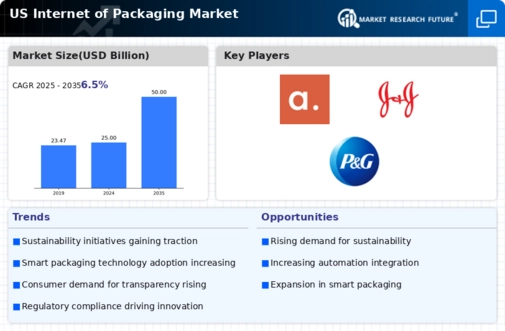Regulatory Compliance and Safety Standards
Regulatory compliance and safety standards are becoming increasingly stringent, driving the need for innovation in the internet of-packaging market. Companies are required to adhere to various regulations concerning product safety, labeling, and environmental impact. This has led to a heightened focus on developing packaging solutions that not only meet these regulations but also enhance product safety. For example, the FDA has established guidelines for food packaging that necessitate the use of materials that do not leach harmful substances. As a result, businesses are investing in smart packaging technologies that ensure compliance while also providing consumers with safety assurances. This emphasis on regulatory adherence is likely to propel growth in the internet of-packaging market as companies strive to meet evolving standards.
Rising Demand for Supply Chain Transparency
The internet of-packaging market is experiencing a notable surge in demand for enhanced supply chain transparency. Companies are increasingly seeking solutions that provide real-time tracking and monitoring of products throughout the supply chain. This trend is driven by consumer expectations for visibility into product origins and handling processes. According to recent data, approximately 70% of consumers in the US express a preference for brands that offer detailed information about their products. As a result, businesses are investing in smart packaging technologies that integrate IoT capabilities, enabling them to share critical information with consumers and stakeholders. This shift not only enhances customer trust but also improves operational efficiency, positioning companies favorably within the competitive landscape of the internet of-packaging market.
Consumer Preference for Personalized Packaging
Consumer preferences are increasingly leaning towards personalized packaging solutions, which is emerging as a key driver in the internet of-packaging market. Brands are recognizing the importance of tailoring packaging to meet individual consumer needs and preferences. This trend is supported by data indicating that 60% of consumers in the US are more likely to purchase products that offer personalized packaging experiences. By utilizing IoT technologies, companies can gather data on consumer behavior and preferences, enabling them to create customized packaging that resonates with their target audience. This not only enhances customer engagement but also fosters brand loyalty, making personalized packaging a vital component of competitive strategy in the internet of-packaging market.
Technological Advancements in Packaging Solutions
Technological advancements are significantly shaping the internet of-packaging market, as innovations in materials and processes are being adopted at an accelerated pace. The introduction of smart sensors, RFID tags, and QR codes has revolutionized how products are packaged and tracked. These technologies facilitate real-time data collection and analysis, allowing companies to optimize their packaging strategies. For instance, the market for smart packaging is projected to reach $30 billion by 2026, indicating a robust growth trajectory. This growth is fueled by the need for improved inventory management and reduced waste, as businesses leverage data-driven insights to enhance their packaging efficiency. Consequently, the integration of advanced technologies is becoming a critical driver for the evolution of the internet of-packaging market.
Sustainability Initiatives and Eco-Conscious Consumerism
Sustainability initiatives are increasingly influencing the internet of-packaging market, as eco-conscious consumerism continues to rise. Consumers are becoming more aware of the environmental impact of packaging materials, leading to a demand for sustainable alternatives. Data suggests that 75% of consumers in the US are willing to pay more for products with eco-friendly packaging. This shift is prompting companies to explore biodegradable materials, recyclable packaging, and reduced plastic usage. By adopting sustainable practices, businesses not only cater to consumer preferences but also enhance their brand image. Consequently, sustainability is emerging as a pivotal driver in the internet of-packaging market, shaping the future of packaging solutions.














Leave a Comment